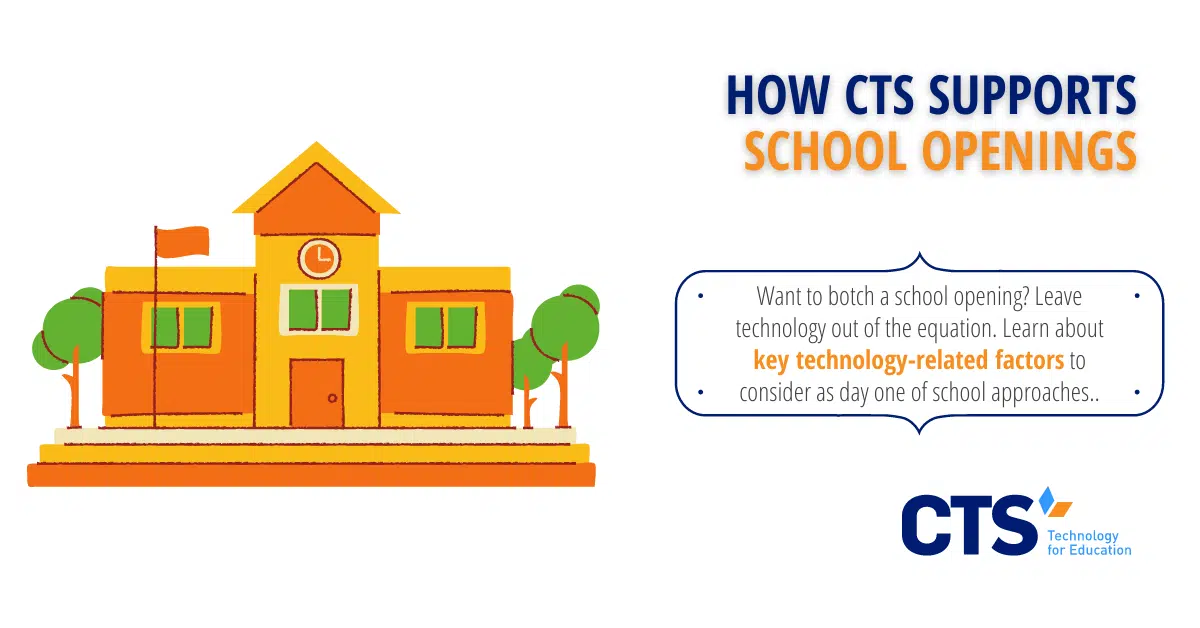When Day 1 arrives, schools have to be ready.
School leaders spend months and months planning for day one of school. This is particularly true for schools that are opening for the first time. The stakes are high, all eyes are on school leadership, and the entire school year is at stake: a haphazard first day of school can undermine teachers’ credibility with students and families and, in turn, undermine teachers’ confidence in school leadership.
What goes into a successful school opening? The inputs number in the hundreds, but a successful school opening accounts for student attrition, facility-related issues, student transportation, special education planning, food service, and of course, technology, among dozens of other topics. Failing to effectively account for just one of these factors can undermine even the most well-planned opening.
Below, we outline how technology planning, in particular, can make or break a school opening. By thinking through the myriad technology-related factors that impact daily instruction, school leaders can effectively plan for a successful school opening.
Want to botch a school opening? Leave technology out of the equation.
It should go without saying that a successful school opening depends on effective technology planning. From bell systems to phone extensions, SMART boards, projectors, teacher laptops, and student devices, technology increasingly impacts each aspect of school programming, particularly instruction.
Students can, on day one, begin working on school assignments using platforms like Google Classroom, while teachers will undoubtedly review students’ prior academic performance using the school’s student information system. Day one of school is also used, in some cases, to diagnose any gaps in student learning: having a data and assessment platform available on day one is crucial to capturing this information.
More generally, teachers have a lot on their plates during the first day–and first few weeks–of a new school year. Reducing any technology-related anxiety can ease the other challenges that inevitably accompany a new school year and allow teachers to keep their focus on educating students.
School openings depend on forward planning.
However, simply desiring a successful school opening isn’t enough: successful school openings necessarily depend on forward planning. We get it. Forward-planning is hard with all of the other competing priorities on school leaders’ plates, but taking the time to forecast the school’s needs weeks and months in advance can ultimately save school leaders significant time and energy.
This belief is especially true for school openings. With dozens of moving parts–arrival, dismissal, lunch, recess, family-teacher conferences, and student diagnostic testing, to name just a few–throwing together a school opening plan at the last minute simply won’t work. Instead, school leaders should convene regular meetings between working groups (e.g., student recruitment, assessment) that plan ahead for the coming school year.
For more established schools, these meetings might happen less frequently and consist mainly of tweaks to existing practices or the development of new protocols in response to changing family preferences or state and local compliance requirements. For new schools, the process is likely much more detailed and intensive. How the new school opens will undoubtedly influence the school opening process for years to come, so establishing an effective plan now can ease the path for successful school openings in the future.
School openings don’t lend themselves to one-size-fits-all solutions.
We’ve kept our advice pretty general here for a reason. Each school is unique, and a one-size-fits-all approach to school openings simply won’t work. What’s effective for a STEM-focused high school won’t work for an arts-based elementary school and vice-versa. Not only are the material needs different (e.g., additional Chromebooks vs. a supply cabinet filled with art supplies), but so are the communities: the preferences of one group of families won’t necessarily mirror those of another group.
For this reason, involving families in the school opening process can set a positive tone for the remainder of the school year, allowing families to feel a part of the school community in a way they may not have at their prior school. When families show up on day one of school, they should be able to locate their contributions in at least some aspect of the school’s programming.
At CTS, we take care of the technology so schools can focus on educating students.
We understand school openings can seem daunting, both for new and experienced school leaders. With all of the moving parts, launching a school can understandably induce anxiety among both administrators and teachers. Our team at CTS has decades of experience in the educational technology sector. Because of this, we have both the technical know-how to execute a successful school launch, as well as a deep understanding of the financial and logistical constraints of schools. Contact us today to learn more about our services and how we can help your school successfully launch and accomplish its unique mission.




